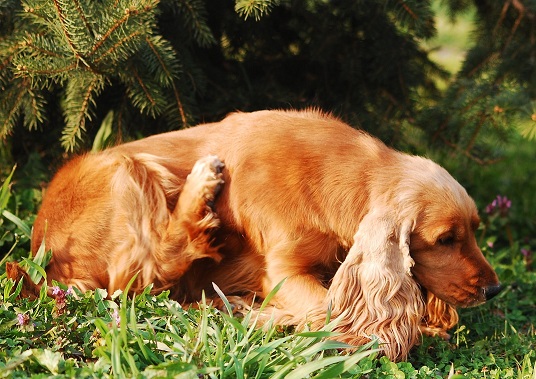Everything a Dog Owner Should Know About
Fleas and Ticks
 If you own a dog, you're probably well aware of all the problems that can be caused by fleas and ticks. Some of them are "less serious", like constant itchiness, while some might even require a trip to the vet's office if not noticed on time. This is why it's always a good idea to know how to get rid of fleas and ticks and how to prevent your dog from getting them ever again.
If you own a dog, you're probably well aware of all the problems that can be caused by fleas and ticks. Some of them are "less serious", like constant itchiness, while some might even require a trip to the vet's office if not noticed on time. This is why it's always a good idea to know how to get rid of fleas and ticks and how to prevent your dog from getting them ever again.
How can you tell if your dog is infected?
Recognizing a dog who has fleas is quite easy - it will probably be scratching itself a lot. Fleas are also not that difficult to spot once you part your dog's fur to see the skin. They prefer to be around the base of the tail, behind the ears, and on the stomach of your dog, but they can be found anywhere, depending on how infected your dog is.
As for the ticks, they might be a bit more difficult to spot at first, especially if your dog has a long coat. In this case, you can use a blow dryer and watch for ticks as you move the dryer over your dog's fur. This is also why you should pay attention to other signs as well. For example, if your dog develops a mild fever, or starts shaking its head after a walk in the park, it could mean that it has ticks in its ear canal. Another reliable way of searching for a tick is by petting your dog and looking for any unusual bumps on their skin. Of course, if you do find a bump, don't ignore it.
How to treat them
 One of the best and most effective ways of getting rid of fleas is by using a flea comb. Just make sure your dog's fur isn't tangled, so as to avoid any additional pain. You should also get a quality flea shampoo or flea powder, depending on your dog's personality; if it hates baths, then the drier options might be better.
One of the best and most effective ways of getting rid of fleas is by using a flea comb. Just make sure your dog's fur isn't tangled, so as to avoid any additional pain. You should also get a quality flea shampoo or flea powder, depending on your dog's personality; if it hates baths, then the drier options might be better.
When it comes to the ticks, if you do notice them, remove them right away. One of the ways of removing a tick from your pet is by using tweezers. What you need to do is grab the tick as close to the skin as you can and remove it without jerking or twisting it. Don't forget to clean the area with alcohol, iodine, or soap and water afterward. You can also use vinegar to ease the process - soak a cotton ball in vinegar and place it on the tick for a few minutes before using the tweezers; ticks hate the smell of vinegar, so most of them will want to get away.
How to prevent them
 You know what they say, prevention is better than cure. Although there are no 100 percent foolproof ways of preventing your dog from catching fleas or ticks, there are ways to reduce that chance to a minimum.
You know what they say, prevention is better than cure. Although there are no 100 percent foolproof ways of preventing your dog from catching fleas or ticks, there are ways to reduce that chance to a minimum.
You should start with your dog's environment. If it lives indoors with you, make sure to vacuum frequently since fleas like warm and moist areas, and we all know that dogs can fall asleep pretty much anywhere. If your dog lives in your yard, keep your lawn cut short, since ticks are usually found in tall grass. Also, there are many quality dog chews that can protect your dog against fleas and ticks, like quality Nexgard for dogs. Just make sure to read the instructions and the label, as it shouldn't be consumed more than once a month.
Finally, there are many flea and tick collars that can keep your dog protected, although their effectiveness still depends on your dog's environment. This is why they should be used mainly as an additional protection and not the only protection.
Fleas and ticks can cause serious issues if not noticed and treated on time. Therefore, check your dog for those parasites after every walk, watch for other symptoms, and if you do notice the pests, make sure to react right away.
See also: Flea Prevention and Treatment for Cats and Dogs
 Zara Lewis is a regular contributor at Highstylife.com and a full time animal lover. Passionate about creating a better world for the generations to come, she is a mum of two, raising them inseparably from their furry family members.
Zara Lewis is a regular contributor at Highstylife.com and a full time animal lover. Passionate about creating a better world for the generations to come, she is a mum of two, raising them inseparably from their furry family members.
